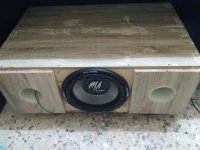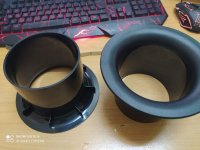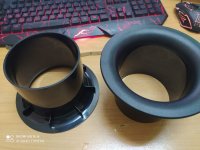Wow, this is a blast from the past, I'm amazed my login still works!
Using Boxnotes, I see that the resonant frequency of the port is 382hz, well above the 230hz your situation develops. A pair of ports with the same effective area will each be the same 45cm in length and have the same resonant frequency. It's hard to see how this would change your situation.
I imagine your tuning frequency is relatively low given the size of the port, so are we talking about a subwoofer here? If so, a low pass filter might be what you want.
You could plug your box dimensions into Boxnotes to see if you have any internal resonances around 230hz and above.
Using Boxnotes, I see that the resonant frequency of the port is 382hz, well above the 230hz your situation develops. A pair of ports with the same effective area will each be the same 45cm in length and have the same resonant frequency. It's hard to see how this would change your situation.
I imagine your tuning frequency is relatively low given the size of the port, so are we talking about a subwoofer here? If so, a low pass filter might be what you want.
You could plug your box dimensions into Boxnotes to see if you have any internal resonances around 230hz and above.
I see that the resonant frequency of the port is 382hz, well above the 230hz your situation develops. A pair of ports with the same effective area will each be the same 45cm in length and have the same resonant frequency. It's hard to see how this would change your situation.
Yes that's what I thought also, but still I wanted to ask if someone has already measured if they are really 100% identical or not.
I imagine your tuning frequency is relatively low given the size of the port, so are we talking about a subwoofer here? If so, a low pass filter might be what you want.
No, it's a woofer&midbass with AE TD12M apollo driver. I know, that at first glance the port seems long, but I tried all different lengths and with this it had the most balanced sound. The port does not muddy the sharpness and it goes pretty low too. Enclosure size is about 75 liters per driver.
You could plug your box dimensions into Boxnotes to see if you have any internal resonances around 230hz and above.
I made this enclosure just for fun, it has 9 sides and they are not parallel to each other, so I cannot enter it to any program I guess.
There are still some resonances inside the box, which i measured by drilling a hole for the mic to the front panel, around 240 hz so that could partly be the culprit.
Holy zombie thread-bump, Batman.
Maybe a few years have passed, but the tech itself has remained the same.
One thing I forgot to mention is that two smaller ports will suffer turbulence at a lower power level than an equivalent single one. See the tests
This might be significant for you given the power rating of that driver.
This might be significant for you given the power rating of that driver.
One thing I forgot to mention is that two smaller ports will suffer turbulence at a lower power level than an equivalent single one. See the tests
This might be significant for you given the power rating of that driver.
Yes, very interesting. After using one port per one 12" driver, I noticed that for me, it's more practical to use one port for two 12" drivers.
The pipe I have used before is 153 mm internal diameter and now I found a 200 mm id pipe.
Two 153 mm ports have 17% bigger area than the single 200mm, however when I put the numbers to the flare calculator (thanks for the link) I noticed that the 200 mm port is actually slightly better... Let's hope the results are correct, or at least in the ballpark.
The only downside is that it requires a bit more space to breathe at the inside of the enclosure, but in my case the enclosure is big enough.
Yes, very interesting. After using one port per one 12" driver, I noticed that for me, it's more practical to use one port for two 12" drivers.
The pipe I have used before is 153 mm internal diameter and now I found a 200 mm id pipe.
Two 153 mm ports have 17% bigger area than the single 200mm, however when I put the numbers to the flare calculator (thanks for the link) I noticed that the 200 mm port is actually slightly better... Let's hope the results are correct, or at least in the ballpark.
The only downside is that it requires a bit more space to breathe at the inside of the enclosure, but in my case the enclosure is big enough.
It actually depends on how you design your enclosure ... for me i decided to play safe i did a diy subwoofer enclosure ported (120L) giant size ... housing a MA Audio MA120XE which has double magnets and double coils. In this case i start to worried that one port might not being able to handle the high port velocity which will result in port noise because reaching the higher port velocity sooner. I run a simulation from WINISD using 2 ports will half the port velocity which is a safer way to go.
For the time being the ports were flanged and there were no port noise noticed so far ... but i end up ordered flared aeroports as upgrade
below here is the current subwoofer and the newly bought aeroports for upgrade
Attachments
One thing I forgot to mention is that two smaller ports will suffer turbulence at a lower power level than an equivalent single one. See the tests
This might be significant for you given the power rating of that driver.
Sorry Mr Collo a little bit off topic here ... i've visited your website too but this time i came across this aeroport i just bought but they have fins at the back ... how actually i am going to install these correctly? thanks
Attachments
@dannyjmf
Normally you make the opening a bit smaller than the outside diameter of the flare and glue them in from the front.
@Machisimo
You are correct. The 200mm port having a smaller CSA than the pair of 153mm ports will flow air at a higher velocity, but it has a higher airspeed capacity as well (provided the flare size is big enough)
The flare-it calculator was based on tests of ports up to 150mm, so 200mm is an extrapolation. I'm sure you'll be fine!
Normally you make the opening a bit smaller than the outside diameter of the flare and glue them in from the front.
@Machisimo
You are correct. The 200mm port having a smaller CSA than the pair of 153mm ports will flow air at a higher velocity, but it has a higher airspeed capacity as well (provided the flare size is big enough)
The flare-it calculator was based on tests of ports up to 150mm, so 200mm is an extrapolation. I'm sure you'll be fine!
I now finished building the ports like I planned and it works and sounds very good, so the theory seems to be correct. 
From now on, I will always optimize my designs to have as few ports as possible. It's something I didn't understand before. For example on this case, I could shorten the port a bit too, because now it didn't need to be so long because of a bit smaller diameter, so it's a real win win situation.
In the previous enclosure I also had this problem: "the high frequencies suddenly start to come through the port quite unfiltered. "
On the new design I put the port to the side of the (round cylinder shaped) enclosure so the end of the port is not right behind the driver, but about 75 degrees rotated when counting from the back of the enclosure. So no longer you can see the back of the driver cone from the port. This removed the high frequency problem. Only thing that's left, which I guess is pretty normal is the port resonance itself, a single peak around 350 hz.
If there is a need to further dampen high frequency content coming out from the port, all I need to do is to add more damping to the enclosure wall area that is visible from the port to reduce the random reflections from there. It's more efficient than damping the whole interior with very thick mat because damping the whole thing reduces the efficiency & the port output too much. Also there aren't many standing waves inside, because the enclosure is cylinder shaped, so thick damping is not required for that purpose either.
Because this speaker is so big, I need to put it right against the wall and therefore putting the port behind the enclosure would have not been possible anyway, since it would not be able to breathe so close to the wall. On the front, ports would have looked ugly and made big holes right next to drivers and would have argued with the round front panel aesthetics. So that was out of the question also.
Now I'm very happy with the design, I feel I really nailed it this time.
From now on, I will always optimize my designs to have as few ports as possible. It's something I didn't understand before. For example on this case, I could shorten the port a bit too, because now it didn't need to be so long because of a bit smaller diameter, so it's a real win win situation.
In the previous enclosure I also had this problem: "the high frequencies suddenly start to come through the port quite unfiltered. "
On the new design I put the port to the side of the (round cylinder shaped) enclosure so the end of the port is not right behind the driver, but about 75 degrees rotated when counting from the back of the enclosure. So no longer you can see the back of the driver cone from the port. This removed the high frequency problem. Only thing that's left, which I guess is pretty normal is the port resonance itself, a single peak around 350 hz.
If there is a need to further dampen high frequency content coming out from the port, all I need to do is to add more damping to the enclosure wall area that is visible from the port to reduce the random reflections from there. It's more efficient than damping the whole interior with very thick mat because damping the whole thing reduces the efficiency & the port output too much. Also there aren't many standing waves inside, because the enclosure is cylinder shaped, so thick damping is not required for that purpose either.
Because this speaker is so big, I need to put it right against the wall and therefore putting the port behind the enclosure would have not been possible anyway, since it would not be able to breathe so close to the wall. On the front, ports would have looked ugly and made big holes right next to drivers and would have argued with the round front panel aesthetics. So that was out of the question also.
Now I'm very happy with the design, I feel I really nailed it this time.
- Status
- This old topic is closed. If you want to reopen this topic, contact a moderator using the "Report Post" button.
- Home
- Loudspeakers
- Subwoofers
- Are multiple ports better ?



